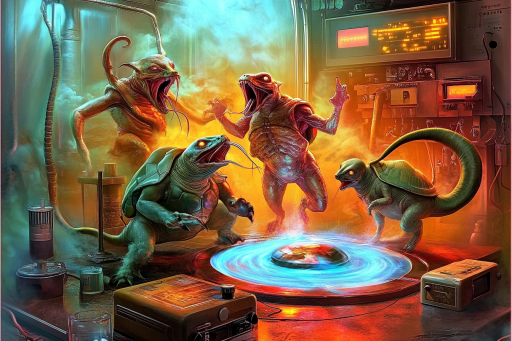
Nature is full of surprises, but sometimes, it produces creatures that defy logic and challenge scientific understanding. Strange mutations have appeared in animals throughout history, baffling researchers and sparking eerie speculation. Some of these anomalies seem to follow no known pattern, leaving experts with more questions than answers. Whether the result of genetics, environmental factors, or something far stranger, these freaky mutations continue to blur the line between science and mystery.
The Two-Headed Snake: A Double Life in One Body

Occasionally, a snake hatches with two fully formed heads, each with its own brain trying to control the body. This rare condition, known as bicephaly, creates a bizarre struggle for survival, as the heads often compete for food and direction. Some two-headed snakes have lived for years in captivity, while others don’t survive long in the wild. Scientists understand how this condition occurs but cannot explain why it happens so unpredictably.
The Cyclops Goat: A Single Eye of Mystery

A baby goat born with a single, enormous eye in the center of its forehead shocked villagers and veterinarians alike. Known as cyclopia, this rare mutation prevents the brain from properly dividing, resulting in a single eye and missing facial structures. While this condition has been observed in various animals, it remains an unpredictable phenomenon. Some cultures have linked it to ancient legends, blurring the line between myth and science.
The Winged Cat: A Feline Anomaly

Several cases of “winged” cats have been reported, with flaps of extra skin resembling wings protruding from their backs. Some believe these growths are simply thickened fur or skin folds, while others think they could be vestigial remnants of an unknown genetic mutation. In some rare cases, these “wings” have even moved slightly, adding to the eerie nature of the phenomenon. No definitive scientific explanation has been given for why some cats develop this strange feature.
The Transparent Frog: A Living Window to Its Own Organs

A rare species of frog has stunned scientists with its transparent skin, allowing a full view of its beating heart and internal organs. While glass frogs are naturally translucent, some mutations have resulted in individuals nearly invisible, blending into their surroundings with an unsettling clarity. This anomaly has led researchers to question how such transparency might provide an evolutionary advantage. The answer remains as elusive as the frogs themselves.
The Octopus with Extra Tentacles: A Deep-Sea Mystery

While octopuses are known for their eight tentacles, rare individuals have been found with up to ten or more. These extra limbs function just like normal tentacles, but scientists still don’t fully understand why they form. Some speculate it could be due to a genetic mutation, while others believe it might be a form of adaptive regeneration. The deep sea continues to harbor creatures that challenge what we know about biology.
The Hairless Raccoon: A Creature from Urban Legends

Occasionally, raccoons are spotted completely devoid of fur, their eerie, wrinkled skin giving them a near-mythical appearance. While some cases are caused by mange, others have no known origin, leading to speculation about radiation, pollution, or a genetic mutation. Their unsettling appearance has fueled countless urban legends, with some even mistaken for cryptids. Despite numerous studies, science has yet to determine why hairlessness occurs in otherwise healthy raccoons.
The Glow-in-the-Dark Turtle: A Bioluminescent Enigma

Scientists were left speechless when they discovered a naturally glowing sea turtle off the coast of the Solomon Islands. Unlike artificially modified bioluminescent animals, this turtle emitted its eerie neon glow naturally, leading to questions about how and why this ability developed. While some deep-sea creatures have evolved bioluminescence, this turtle was found in much shallower waters. Its mysterious glow remains unexplained, hinting at undiscovered aspects of marine biology.
The Legless Lizard: Neither Snake nor Lizard

A strange reptile that looks like a snake but behaves like a lizard has baffled researchers for decades. While some species of lizards naturally lose their legs over evolutionary time, mutations have caused modern legless lizards to appear where they shouldn’t. Their movement, diet, and bone structure do not match any known evolutionary path. This strange anomaly raises questions about how creatures adapt—and whether some mutations reverse evolution entirely.
The Six-Legged Frog: A Leap into the Unknown

In multiple locations, frogs have been discovered with extra limbs, sometimes fully functioning and other times twisted or useless. While some attribute these mutations to pollution or parasites, no consistent cause has been identified. These frogs appear healthy apart from their extra legs, leaving researchers puzzled about how such growths form without harming the animal. The true cause remains one of the great unanswered questions in modern biology.
The Albino Peacock: A Ghostly Display

A rare genetic mutation can strip a peacock of all its vibrant colors, leaving behind pure white feathers that shimmer like a ghostly apparition. Unlike typical albino animals, these peacocks retain their piercing blue eyes, adding to their ethereal presence. While the genetics behind albinism are understood, why it appears so rarely in peafowl remains a mystery. Their haunting beauty continues to mystify scientists and bird enthusiasts alike.
The Two-Mouthed Fish: A Strange Catch

Fishermen have occasionally caught fish with two fully developed mouths, both functional but often asymmetrical. Some cases have been linked to pollution, while others appear entirely natural, raising questions about genetic instability in aquatic life. Despite extensive study, there is no single explanation for this strange phenomenon. Every new catch adds another layer to this puzzling mystery.
The Half-Mammal, Half-Reptile Mystery

Reports have surfaced of animals exhibiting both mammalian and reptilian traits, defying traditional classification. Some have the warm-blooded metabolism of mammals but the scales of reptiles, creating an evolutionary paradox. These anomalies remain largely undocumented, as they often disappear before scientists can study them. Whether these are genetic throwbacks or signs of undiscovered species remains uncertain.
The Winged Rat: More Than Just a Mutation?

Some urban explorers have reported finding rodents with small, wing-like appendages that appear to be more than just loose skin folds. Unlike bats, these rats do not seem capable of flight but exhibit strange gliding behaviors that have baffled researchers. This phenomenon remains poorly studied, with most reports coming from remote areas or abandoned buildings. Whether this mutation is natural or the result of environmental changes remains a lingering question in the scientific community.
The Four-Eyed Turtle: An Evolutionary Anomaly

A few rare turtles have been documented with four functioning eyes, a condition that defies known genetic mutations. While some animals develop extra limbs or heads due to cellular errors, an additional set of working eyes presents a unique mystery. These turtles appear to function normally, despite their bizarre trait, leaving scientists wondering what advantage—if any—this mutation provides. As more discoveries emerge, this genetic enigma only deepens.
The Horned Rabbit: A Myth Come to Life

Throughout history, legends have told of horned rabbits, often dismissed as folklore—until real cases emerged. Some rabbits develop horn-like growths due to a rare virus that causes keratinous tumors to form on their heads. While these growths are not true horns, their eerie resemblance to mythical jackalopes has fueled speculation for centuries. The mysterious appearance of these creatures blurs the line between legend and reality.
Reality Bends: Nature’s Strangest Creations

Some mutations offer clear scientific explanations, but others remain as baffling as the day they were discovered. Evolution is full of strange twists, and sometimes, nature produces creatures that defy our understanding of biology. Whether caused by genetics, environment, or unknown forces, these anomalies remind us that life is still full of surprises. Perhaps the greatest mystery is how many more bizarre creatures are waiting to be found.





